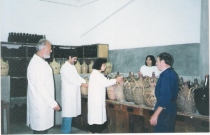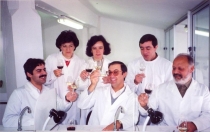Quality ranking of wines from specific grapevine varieties
Measures
In the 1970s, plantings in Portugal were mostly carried out on site by local grafting onto rootstock using material from the vineyard itself, often containing more than one grapevine variety, without any guarantee in respect of the V. vinifera graft cuttings. It was in the late 1980s that oenologists became aware of the benefit of the particular organoleptic properties of the more important grapevine varieties.
Rudimentary structures for microvinification were in place at the University of Évora’s experimental winery at Mitra. Meaningful results were obtained for red wines especially. Through its contact with Raposo Palma, PLANSEL has been investing in the expansion of technical facilities since 1981, particularly with a view to ensuring hygiene and control in modern microvinification fermentation processes. Fermentation of white wines takes place in a refrigerated container. A little later, PLANSEL arranged for DAAD (the Deutscher Akademischer Austauschdienst, or German Academic Exchange Service) to finance a scientific exchange for university lecturer Colaço do Rosário to visit the Geisenheim Research Center’s Grapevine Breeding Department (under Prof. H. Becker) in order to broaden his knowledge on controlled fermentation techniques.
Based on results from the experimental winery at Mitra, the suitability of autochthonous varieties of the regions was systematically studied in 1983. PLANSEL also had grapes from the most important reference grapevine varieties in the country delivered to Mitra, with particular emphasis placed on the viticultural regions of the north: the Dão and the Douro. At the same time, these varieties were planted in PLANSEL field trials in Montemor.
Within the context of EU accession negotiations, a project was financed to equip the University of Évora’s experimental winery at Mitra with facilities housing state‑of‑the‑art winery and laboratory technologies. Wine tastings with national and international committees were carried out in order to ensure that applied assessment criteria to determine a wine’s quality ranking corresponded with the market.
Project studies
Comparative testing of varietal wines in Portugal and abroad in order to compile a quality ranking table (1985–1989)
- University of Évora’s experimental winery at Mitra (Project led by Ario de Azevedo and Colaço do Rosário)
- Laboratory of the Wine Institute in Catujal, systematic wine tasting and analyses (Project led by Tomas Correia and Virgílio Dantas)
- Masters of Wine, London (Led by Jancis Robinson)
- Winery technonology – Geisenheim Research Center
- ETAV with collaboration from professors of the University of Montpellier (Led by C. Vallat and Prof. Truel)
- University of California, Davis (Prof. João A. Araújo)
Dissemination measures
- 1980s: Wine tastings at the University of Évora’s exprimental winery at Mitra with wine producers and winemakers.
- External wine tastings at technical events within the profession (Led by Colaço do Rosario)
- 1986: Public presentation of the results of the PLANSEL/University of Évora microvinification project, with wines from the Douro Region Research Institute in the IVV headquarters in Catujal.
Publications
- Establishing facilities devoted to propagation material for Portuguese white grapevine varieties. Colaço do Rosário, Mota Barroso; Vida rural No. 223 (January 1986)
- The best Portuguese cask wines from 1986. Hans Jörg Böhm, Alles über Wein No. 2/88 (1988)




